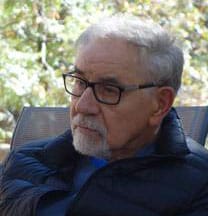There is probably no Israel tour quite like that offered by Lydia Aisenberg, which focuses on the Green Line — the demarcation between Israel and its neighbors set in the 1949 Armistice Agreement after the end of Israel’s War of Independence. Since 1967, when Israel took military control of the area east of it, the Green Line has been controversial.
“Over the last few decades, there’s been a concerted effort in Israel to blur the Green Line,” Aisenberg said, handing out a map showing the line in green, as well as an orange line marking the security wall and a blue line marking the 1947 boundary rejected by Jordan and other neighbors. Aisenberg said that taking visitors to the Green Line is considered disloyal by some Israelis. On one occasion, when she brought a group of European visitors to a checkpoint near the Green Line, an Israeli military guard called the 69-year-old a zona — a prostitute.
“That’s when humor kicks in,” she said. “So I tell the guard at the checkpoint: ‘I’m delighted that you think a young man would spend good money to sleep with me!’ ”
Aisenberg’s tour of the Green Line and related locations is offered under the auspices of Givat Haviva, an Israeli-based nonprofit located in northern Israel. Founded in 1949, Givat Haviva (The Israeli Arab town of Barta’a.
Although the physical barrier is no longer there, another kind of barrier persists: Those who live in West Barta’a are Israeli citizens while the Arabs who live in East Barta’a are not, and are thus not covered by Israeli institutions, such as universal health care. On the other hand, East Barta’a isn’t hampered by Israeli laws. As a result, East Barta’a has turned into a bustling free-trade zone where Israelis — Arabs and Jews — buy cheap goods.
 Stylish hijabs for sale in a Barta’a store window
Stylish hijabs for sale in a Barta’a store window
Aisenberg greeted and was greeted by Barta’a residents on both sides of town, Arabs who know her well. Those on the tour got a chance to interact with Aisenberg’s Arab friends, and she told poignant stories the residents have shared with her about their lives. Aisenberg said she sees Barta’a —where families are split by two different citizenships — as “a concrete, potent symbol” for Israel’s condition.
And that’s when it became clear to Rafi that the aim of Aisenberg’s tour is to ask: How can Israeli Arabs and Jews find ways to connect with one another? The idea of a shared society is fundamental to Aisenberg’s — and Givat Haviva’s — vision for what Israel can become: a place where, Aisenberg said, “Arab citizens feel they have a stake in Israel’s future.”
Aisenberg is not naïve. She knows that she and Givat Haviva, advocating for peace and understanding, are swimming against the tide. But the latest round of violence hasn’t dampened Aisenberg’s — or Givat Haviva’s — determination to educate Israeli Jews and Israeli Arabs in the importance of learning each other’s narrative.
“We talk about the Green Line so that foreigners and Israeli citizens are better informed, so that judgments are based on facts, not on beliefs,” Aisenberg said. “By showing people both sides of the situation, with any luck, we can become neighbors instead of enemies.”























 More news and opinions than at a Shabbat dinner, right in your inbox.
More news and opinions than at a Shabbat dinner, right in your inbox.